These top 10 religious places in Nepal are some religious places where gods and goddesses are said to reside. Thousands of pilgrims pay homage to these religious places with utmost belief.
Nepal is not only famous for spectacular trekking destinations but also, known for being a home to thousands of years old religious heritages and sites.
Similarly, Nepal is known to be the home of 33 million gods and goddesses, and there are several temples and sites dedicated to these gods in different corners of Nepal.
Nepal is also well-known for religious tourism where people visit several religious places to worship and take blessings from god.
Most of these sacred places have mythological significance. Being a traditional society, people have faith and belief in the power of these places that bring solace to their life.
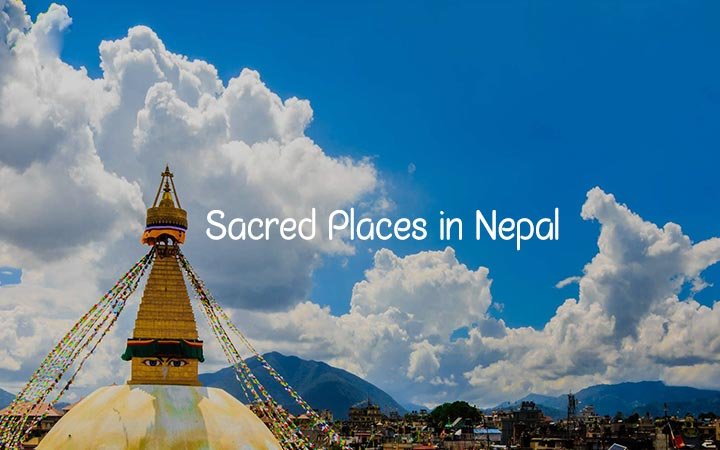
Why do Nepalese Visit Holy Places?
Nepal is a secular country where people of different religions live in harmony. The majority of Nepalese follow Hinduism and Buddhism in Nepal.
Moreover, religion is prevalent in the everyday life of Nepalese. They celebrate various festivals, occasions, and rituals throughout the year that have been significant from the ancient period.
Among the festivals, Dashain, Tihar, Teej, Holi, etc are the most celebrated festivals in Nepal.
The religious places of Nepal have a history that dates back to the time before the whole of Nepal was unified. The places that are part of Nepal used to be separate kingdoms.
And, the people worshipped gods in their kingdom. So, many of the temples were present before the unification of Nepal.
King Prithivi Narayan Shah is known to have unified the small kingdoms to create Nepal. The king himself was a devotee of Lord Gorakhnath.
Afterward, several kings ruled Nepal and many of them built temples in different places. So, most of the temples here are ancient and have unique architecture.
Nepalese visit these sacred places because they have the utmost belief in the presence of God in these places. The religious mythologies attached to these sacred places have kept people religious to date.
When people visit these religious places, they offer fruits, sweets, garlands, vermilion powder, incense sticks, and so on. Then they bow down to the god’s shrine to take blessings.
People believe their wish gets fulfilled when they visit the temple and pray. They believe visiting temples brings positivity and a good omen in their life. Their sins are forgiven and the God will protect them from evil.
List of Religious Places in Nepal

There are several sacred places in Nepal but here is the list of the top 10 religious places in Nepal that Nepalese visit more often.
These sacred places have ancient history and mythologies attached to them. You can visit these places on a religious tour and take blessings from god.
1. Pashupatinath Temple

One of the sacred temples in Nepal is the Pashupatinath temple. It is located in Kathmandu on the banks of the Bagmati river. It is the biggest temple of Lord Shiva that is visited by thousands of Hindu pilgrims every year.
Hindus and Buddhists visit Pashupatinath any time of the year. But, it is mostly crowded during festivals like Teej and Shivaratri.
During Teej, married and unmarried women take a fast and worship Lord Shiva for the good health of their present or future husband.
Similarly, Hindu devotees worship Lord Shiva during Shivaratri, which also marks the end of the winter season.
The temple has pagoda-style architecture, and the complex has four silver gates facing four directions. The roof of the temple is gold plated and inside the temple resides a huge Shiva-linga.
The holy temple of Pashupatinath is inscribed on the UNESCO World Heritage Sites list, so it is a protected area.
At the foot of the Pashupatinath, Hindus perform the cremation. The night aarti is also one of the attractions of the Pashupatinath temple.
Priests perform a spectacular aarti every night dedicated to Pashupatinath. Hundreds of pilgrims come to Pashupatinath to watch this aarti, which brings peace and positivity to them.
At a sacred place like Pashupatinath, wearing leather belts and clicking pictures is strictly prohibited.
The mysterious idol of Vipupakshya is also present at Pashupatinath by the bank of the Bagmati river.
According to Hindu mythology, Virupakshya, also known as ‘Kali’, was a man who once unintentionally had a sexual relationship with his own mother.
This event is also said to commence ‘the Kaliyug’ period. Out of utmost regret, Virupakshya went to Lord Shiva for repentance.
But again, Virupakshya unintentionally burns the face of Lord shiva while opening the lid of the hot utensil by the vapor.
Lord Shiva was so angry that he ran behind Virupakshya to kill him. Virupakshya then went to Lord Budhha and asked to save him. Lord Buddha gave him guidance to repent and a solution to hide him from Lord Shiva.
Lord Budhha asked him to hide beneath the ground where Lord Shiva cannot find him and emerge slowly as time passes. It is said that once the Kali fully emerges from the ground, his repentance completes, and the Kaliyug will end.
Recommended Reading: 20 Facts about Pashupatinath Temple
2. Boudhanath Stupa
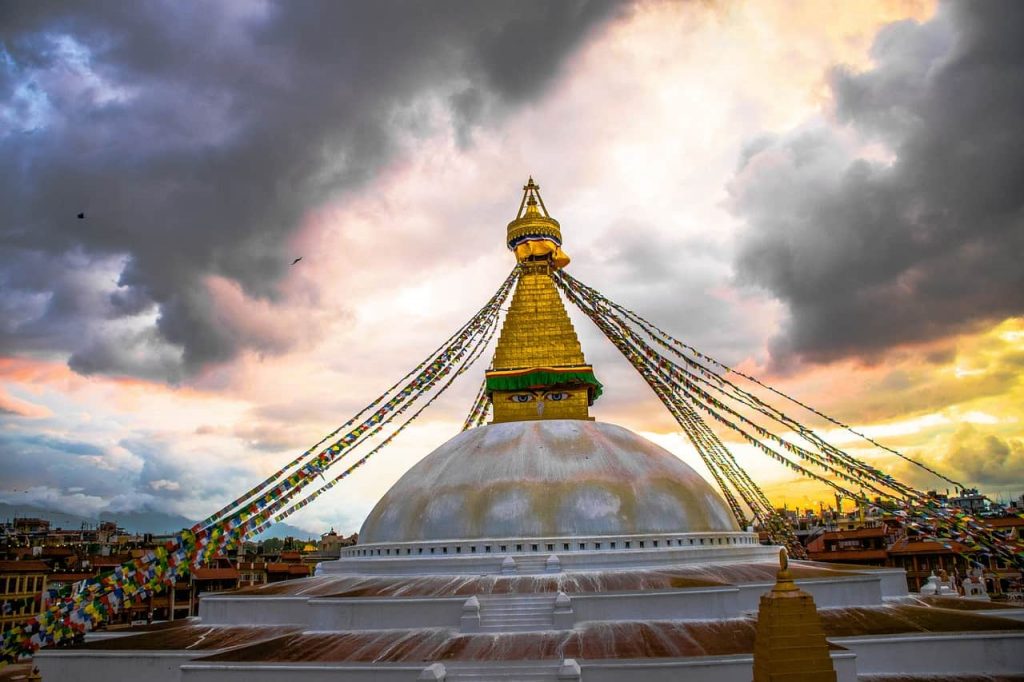
Boudhanath is a beautiful place inside the Kathmandu valley where lies the Boudhanath stupa. Boudhanath stupa is Nepal’s one of the UNESCO World Heritage sites located 8 km east of Kathmandu.
Boudha stupa is the largest stupa in the Kathmandu Valley. It is a giant round white structure that has an inverted cone-like structure crown made up of gold.
On each side are painted the awakening eyes of the Buddha that symbolize awareness. The stupa has attached manes. The pilgrims circle the stupa while rotating manes.
Boudhanath stupa is religious among Buddhist pilgrims. There is a hall for monks and pilgrims to chant prayers and worship Buddha right in front of the stupa.
Boudha is a vibrant market occupied by several shops and restaurants. Boudha is mostly crowded during Buddha Jayanti, which is the day celebrated as the birthday of Lord Budhha.
3. Muktinath Temple
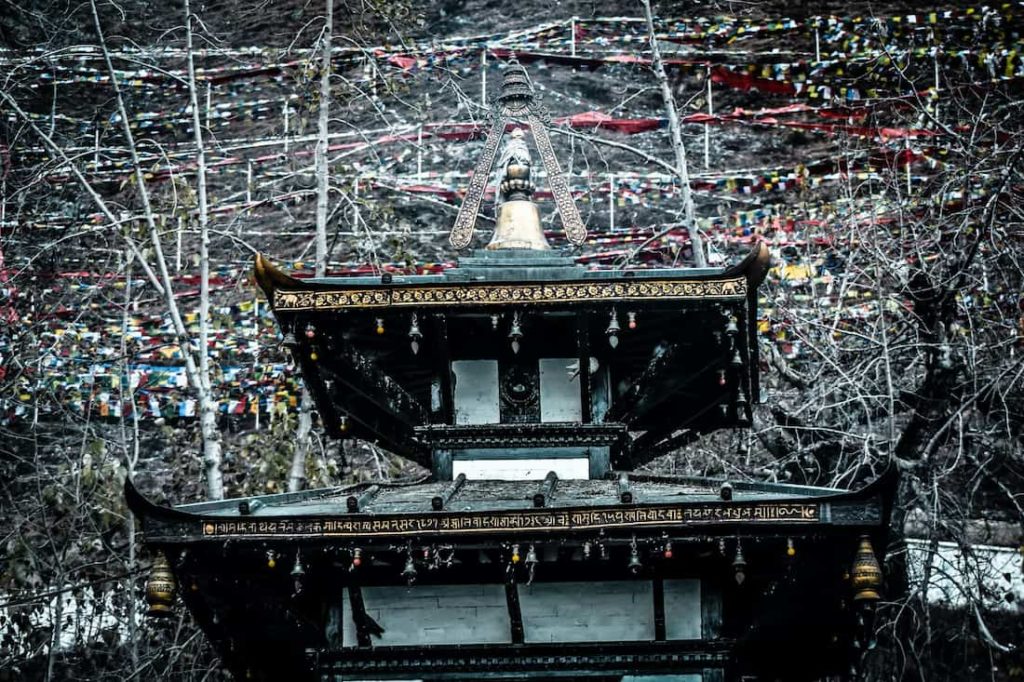
Muktinath temple is one of the religious temples located in the Mustang district of Nepal. It resides at an elevation of 3710m, which is quite a high altitude.
Mukti refers to salvation. It is said that visiting Muktinath at least once in life will wash away all your sins and cleanse your soul.
The architecture of the Muktinath temple is constructed in the pagoda style. The 108 waterspouts behind the temple are known as “Muktidhara ”.
The devotees visiting the temple take bath in that tap water, which is said to release all the negativity from the body and bestow salvation.
You have two options to reach Muktinath. You can either take a flight from Kathmandu to Pokhara and then fly to Jomsom or take a road trip via jeep. The flight takes only 25 minutes to reach Muktinath temple whereas the road trip will take 2 to 3 days.
4. Swayambhunath Stupa
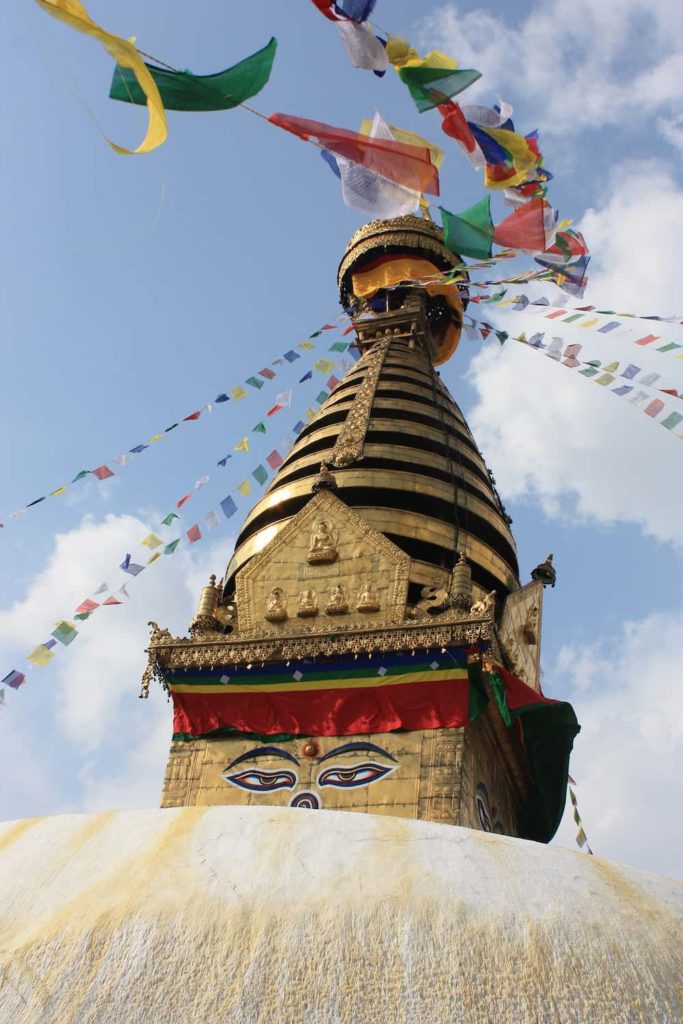
One of the sacred places among Buddhist pilgrims is the Swayambhunath temple, located in Kathmandu. Pilgrims of any religious background visit Swayambhunath.
It is one of the oldest religious places in Nepal and is cited as a UNESCO world heritage site.
According to mythology, it is said that Kathmandu Valley was a large lake. Manjushree saw a huge lotus pondering upon the lake. Manjushree then cut off the Chovar hill and drained the water out.
And that was how Kathmandu Valley originated. Similarly, the place where the lotus was blooming is said to be Swayambhu.
Just like the Boudha stupa, a giant stupa lies at the top of Swayambhunath which is 36 meters tall.
Similarly, there is a monastery, a temple of goddess Harati, numerous manes, and a giant gold antique structure that lies in front of the 365 staircases.
The temple of goddess Harati is considered sacred. It is said that she protects the children from evil. That’s why people bring their children to the temple and they pray to the goddess to protect their child from evil eyes.
Swayambhu is also a popular holiday destination among locals who come to spend a peaceful time here.
Swayambhu is also known for the spectacular view of Kathmandu valley that it offers from the top of Swayambhu.
5. Lumbini
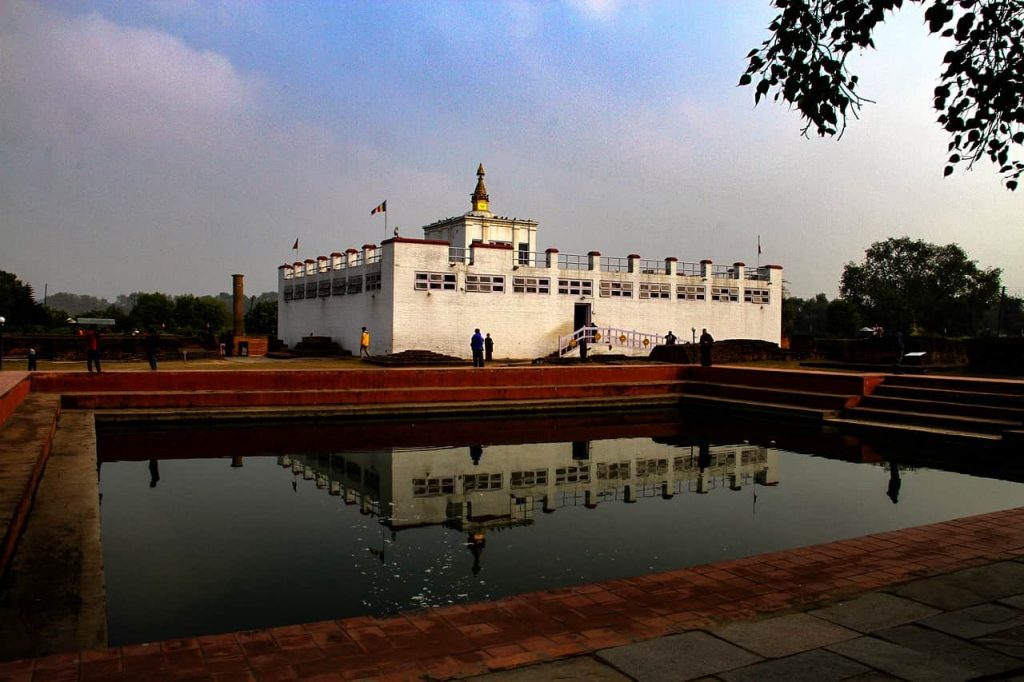
Lumbini is a sacred place in Nepal, where Lord Budhha, the Light of Asia, was born. Lumbini is also a UNESCO world heritage site. Visitors from around the world come to Lumbini to take a tour of the place.
The sacred lake where the mother of Lord Buddha, Maya Devi used to take bath is still preserved at Lumbini.
Similarly, the renowned Ashoka Pillar, Maya Devi temple, monasteries, and the remains of the Lumbini palace are the main attraction of Lumbini.
Lumbini is one of the world’s most spiritual plots where pilgrims find peace from within. There are more than 25 internationally built Buddhist monasteries on the premise of Lumbini.
The Ashoka Pillar is considered to indicate the spot where Lord Budhha was born. It is believed that the Buddha walked his first seven steps right after his birth.
We can conveniently reach Lumbini from Kathmandu either by taking a 30 minutes flight from Kathmandu airport to Bhairahawa airport or we can take a road trip that takes around 10 hours.
6. Manakamana Temple

Manakamana temple is a religious temple of Goddess Manakamana Devi located in the Gorkha district of Nepal. The literal meaning of Manakamana in Nepali is Heart’s wish.
Manakamana Devi is said to fulfill the wishes of pilgrims who visit the temple. The temple is situated at an elevation of 3900ft in the Gorkha district of Nepal.
You can reach Manakamana on foot but there is a cable car facility too. Walking may take several days so the convenient way to go to Manakamana is via cable car.
Manakamana cable car is probably the first cable car service in Nepal, which made it easier for devotees to visit Manakamana Devi and return home in a single day. During weekends, the crowd is exceptional at Manakamana.
From Kurintar, Pilgrims travel in a 2.8 km long ride in a cable car to the temple base. The hilltop offers a stunning view of some high peaks such as Ganesh, Manaslu, Annapurna, etc.
7. Janakpur Mandir

Janaki Mandir is a Hindu temple located in the Janakpur district of Nepal. The temple is named after the Hindu Goddess Sita, who was the daughter of King Janak.
She later married the Hindu God, Ram as mentioned in the sacred Hindu epic, Ramayana. Inside the temple, there are several idols of Ram and Sita together.
Janakpur temple is a massive architecture constructed in an area of 4,860 sq. feet. The giant building has unique architecture and is decorated with multiple colors making it vibrant and attractive.
It is a three-storied structure made entirely of stone and marble. All its 60 rooms are decorated with colored glass, engravings, statues, and paintings, with beautiful lattice windows and turrets.
The massive palace of Janakpur has Mithila architecture. The architecture is incredibly beautiful, which attracts a lot of tourists every year.
8. Kalinchowk Bhagwati

Kalinchowk Bhagwati temple is a sacred temple located in the Dolakha district of Nepal. It is situated at an altitude of 3842m from sea level.
No one knows about the origin of this temple. But, the temple has been there since ancient times.
Though it is a temple of the fierce goddess, there is no rigid sculpture of the goddess. There is a 3 ft deep hollow where water never dries.
Pilgrims worship that sacred hollow as god and hang small bells and Trishul over the small cliff. They even sacrifice birds and animals as offerings to the goddess.
In the winter season, heavy snow falls at Kalinchowk. Kalinchowk is a popular trekking destination among trekkers too.
It is a part of the Gaurishankar conservation area, from where two rivers SunKoshi and Tama Koshi rivers originate. The top of the hill offers a spectacular view of Gaurishankar Himal.
According to ancient mythology, Kali Devi performed penance in the name of Gauri-Shankar (Shiva and Parvati) at Kalinchowk hill, where lies the temple now. So, it is not possible for anyone to climb the Gaurishankar mountain.
It is believed that Shiva and Parvati live on that mountain. It is said that those who have tried to climb the mountain have never returned.
9. Gosaikunda
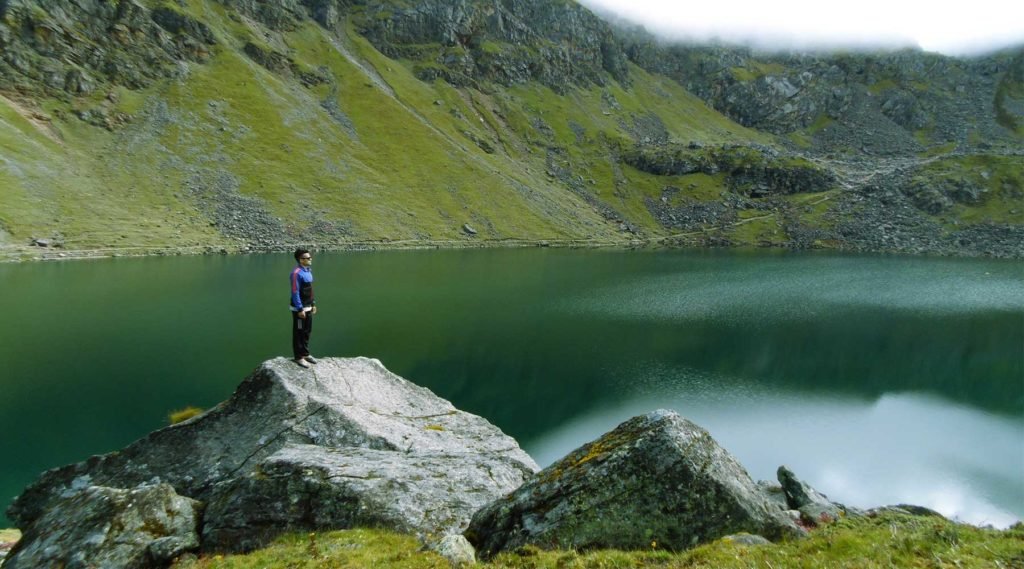
Gosainkunda is one of the largest and most religious lakes located inside the Langtang National Park. It resides at an altitude of 4,380m in the Rasuwa district of Nepal.
The lake flows down to unite with the Trishuli River and remains frozen for six months in the winter season. 108 small lakes are visually incredible.
Trekking to Gosaikunda is one of the toughest treks in Nepal. Gosaikunda is one of those sacred places in Nepal that is located at the highest altitudes.
Gosaikunda holds religious significance in Nepal. According to Hindu mythology, the poison released during Samudra Manthan was about to destroy the world.
To save the world from the vicious poison, Lord Shiva swallowed the poison. He then kept the poison in his throat and didn’t swallow it fully.
Since the poison was burning his throat, it is said that to calm the burn, he thrust his Trishul (holy Trident) into the mountain and extracted water. Since then, Hindu pilgrims believe that Lord Shiva is sleeping under Gosaikunda.
Hindu pilgrims visit Gosaikunda to take bath in the holy water. It is said to wash all the sins and diseases. Though the holy water of Gosaikunda is ice cold, pilgrims take long numerous dips while chanting the name of Lord Shiva.
10. Pathivara Devi
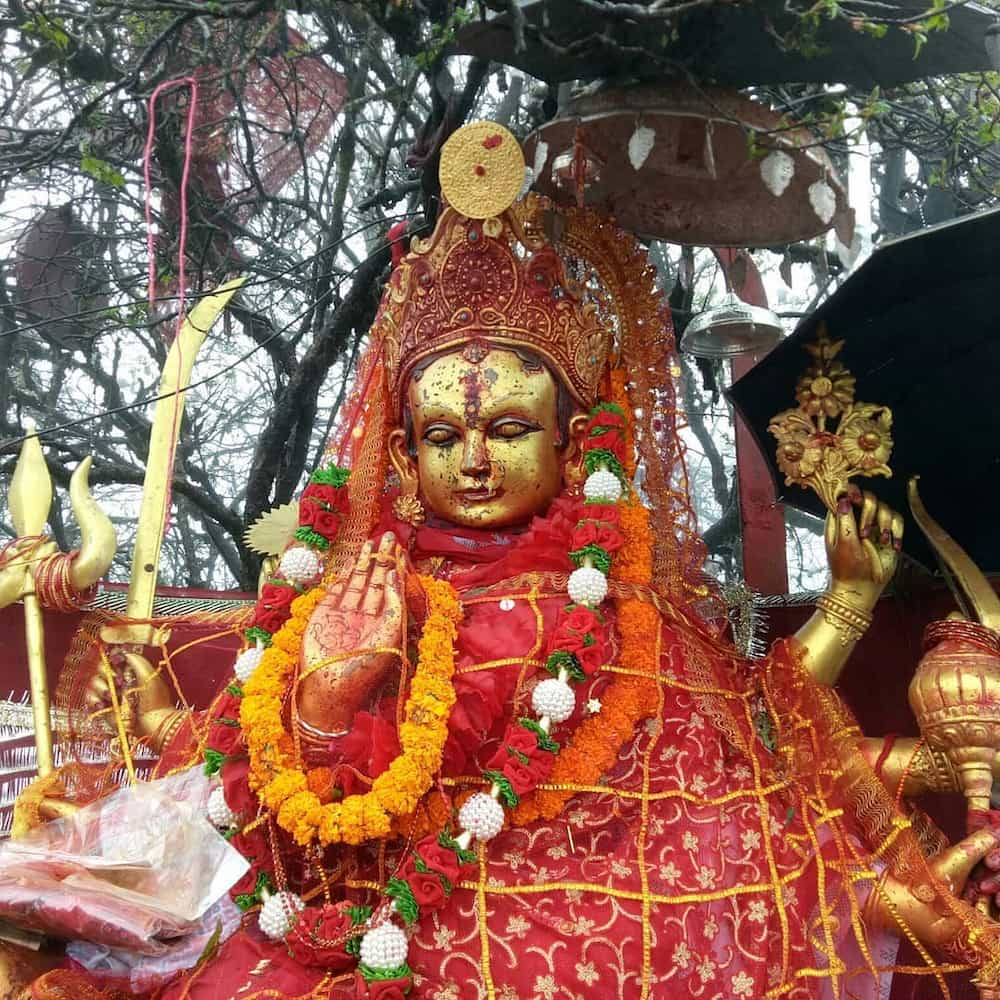
Pathivara Devi is a sacred goddess of Hindus in Nepal. Pathivara Devi temple is located at Taplejung at an altitude of 3,794 m (12,448 ft). Pathivara Devis is said to fulfill all our prayers if we visit her temple and worship her.
Even the royal families in the past used to visit Pathivara Devi to pray for the protection of the country. Pilgrims from any religious background can visit the Pathivara Devi temple.
The idol of the goddess looks fierce as she sits on the lion with a Trishul. It is said that, if you speak of going to Pathivara temple, you must visit no matter how. Else, it will be a bad omen.
The religious temple of Pathivara Devi resides on the hill of Pathivara, which takes about a week to reach. It is not a piece of cake to land up at the foot of Pathivara Devi. You must be able to walk for long hours on elevated steep paths.
It is also a popular destination among trekkers. Most trekkers go for the Taplejung trek during the winter season to enjoy snowfall and spectacular views of mountain ranges.
Conclusion
These top 10 religious places of Nepal have had important significance since ancient times. Other than these 10 places, there are several sacred places such as Bajrayogini temple, Bhaleshwor Mahadev, Bindabasini temple, Changunarayan temple, Palanchowk Bhagwati, and many more.
Anyone with pure intention and spirituality can visit these sacred places. You can even plan a trekking tour to these sacred places and go on a spiritual journey with your friends and families.
Visiting sacred places brings positivity and good luck in life. If you can, do visit above mentioned places at least once in your life.
If you have any queries, drop them in the comment section below.